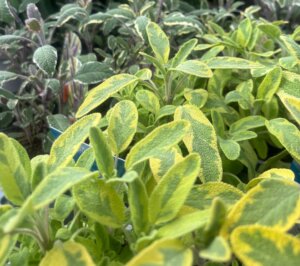Sage (Salvia officinalis) is a hardy perennial herb that brings flavour, fragrance, and wellness to your home and garden. Originating in the Mediterranean, people have used sage for centuries in cooking, traditional medicine, and spiritual practices. Its soft, silvery-green leaves carry a pungent, earthy aroma and a slightly peppery flavour—ideal for seasoning poultry, stuffing, and roasted vegetables.
Sage goes beyond the kitchen. It offers anti-inflammatory, antioxidant, and antimicrobial benefits—perfect for teas or herbal oil infusions. In modern wellness, many use it to support digestion, soothe sore throats, and boost cognitive health. Because sage is tough and easy to care for, gardeners often grow it in beds, borders, and containers.
Tip from greenhouse manager Clayre:
“If you want an interesting-looking sage, definitely go for Pineapple Sage! When it flowers, it produces long spires of magenta-red petals!”

Did You Know? Sage Was Once Used as Currency!
In the Middle Ages, sage held such high value in China that merchants traded it for tea. In fact, two crates of Chinese tea could equal one crate of European sage!
Growing Sage in the UK
Sage grows especially well in the UK. This hardy perennial handles most British winters as long as you protect it from excess damp.
Hardy Plants Manager Paul says:
“Sage is an incredible herb because it’s so hardy! Once you plant it in the garden, just cut it back in autumn—it’ll return stronger and add wonderful flavour to your meals!”
Climate & Hardiness
Sage prefers a Mediterranean-style climate with warm, dry summers. However, it adapts well to the UK’s temperate conditions. It tolerates temperatures down to –15°C, so it suits most British winters. In wetter areas, mulch around the plant or grow sage in pots so you can move it under cover.
Soil Requirements
Sage thrives in well-drained soil. If your garden has heavy or clay soil, add sand, grit, or organic matter to improve drainage. Choose low to moderately fertile soil for best flavour—overly rich soil can weaken the aroma of the leaves.

Is Sage Easy to Grow?
Yes—sage is low-maintenance and beginner-friendly. Give it full sun, dry conditions, and well-drained soil. Avoid overwatering, and it will reward you with fragrant, flavourful growth year after year.
Propagation
You can propagate sage in several easy and effective ways:
Cuttings: Take softwood cuttings from non-flowering stems in late spring or early summer. Strip the lower leaves and plant the cuttings in gritty, free-draining compost.
Division: In early spring or autumn, dig up a mature plant and divide the root ball. Replant each section immediately in well-drained soil.
Layering: In spring or summer, bend a low-growing stem to the ground and cover part of it with soil. Once it roots, cut and replant it.
Seeds: Sow indoors in early spring or directly outdoors in late spring. Germination takes 2–3 weeks. Transplant once seedlings grow strong enough.
Planting
Plant sage in a sunny, sheltered location. Space plants 40–60 cm apart for good airflow and plant them at the same depth as in their pots. Water well after planting, then allow the soil to dry between waterings. For pots, use a container with drainage holes and a gritty compost mix. Harvest and prune regularly to keep the plant compact and healthy.

Winter Care
Although sage survives most UK winters, it benefits from extra care in cold or wet conditions. Keep the soil well-drained to prevent root rot. In very wet climates, grow sage in containers and move them under cover during heavy rain or frost.
Pruning & Harvesting
Prune sage regularly to keep it compact and encourage fresh growth. In spring, trim back leggy or woody stems once new growth appears. Avoid cutting into old wood.
Harvest sage in the morning by snipping young leaves or soft stems. Harvest often, but never take more than one-third of the plant at once. In late summer, prune more thoroughly to prevent woodiness. Skip pruning in autumn to protect the plant’s winter hardiness.

Storage
Store sage fresh, dried, or frozen to enjoy its flavour all year:
Fresh: Wrap sprigs in a damp paper towel and place them in a resealable bag. Keep them in the fridge for up to a week.
Dried: Hang small bunches upside down in a warm, dry, and well-ventilated area out of direct sunlight. Once dry and crumbly, strip the leaves and store them in an airtight jar in a cool, dark place.
Frozen: Chop fresh leaves and freeze them in ice cube trays with a little water or olive oil—ready to drop into recipes.
Sage offers so many benefits. It’s hardy, drought-tolerant, and pest-resistant. Its fragrant leaves bring flavour to your meals, attract pollinators, and support wellness. Whether in garden beds or containers, sage thrives with minimal care and looks attractive year-round.
Start growing sage today—you’ll love how easy and rewarding it is to add this amazing herb to your garden!
